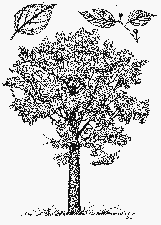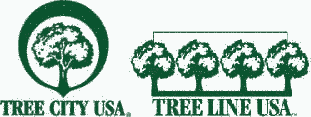



hackberry
Celtis occidentalis
Hackberry is a medium, deciduous tree with a mature height and spread of 40 to 60 feet. Excellent for wildlife, it is also useful for landscaping. Appropriate for medium yards, the upward arching limbs add beauty to any yard. Several minor pests may affect this specie, though most do not cause problems. Only the Eriophyid mite, which causes “witches brooms” is of concern. The purple drupe may be a problem for some locations. The cultivar “Prairie Pride” is a great choice with its´ resistance to having “witches brooms” and less fruit.
Native Range:

Plant illustration by Dale Larison, Missouri Department of Conservation
Range map modified from USDA Forest Service Silvics of North America Web site - www.na.fs.fed.us/spfo/
pubs/silvics_manual/
Volume_2/celtis/
occidentalis.htm
Reach for the Tree Care Benchmark

|
Tree City USA and Tree Line USA are great benchmarks to measure how your community or utility are caring for trees. The accomplishments for these recognition programs are accumulated during the calendar year. Now is the time to plan for your 2005 activities to meet the standards.
Many communities and utilities already meet the minimum standards, but have not formalized or account for them. Start recording all activities related to trees. This includes training of staff, public education, pruning, planting, tree removal, street tree inventories, meetings, ordinance or utility policy creation / modification, Arbor Day proclamation and celebration, and other activities.
Communities and utilities interested in earning Tree City USA and Tree Line USA recognition do not have to go far for help to get started. The Missouri Department of Conservation foresters are available to help plan for this accomplishment. Many of the communities and utilities that already have earned this recognition are more than willing to share their experience to help you get started.
To learn more about Tree City USA or Tree Line USA contact your MDC Urban Forester, Jon Skinner (Jon.Skinner@mdc.mo.gov), 417-629-3423 or visit the National Arbor Day Foundation web site at www.arborday.org/programs/index.cfm.
Building Effective Partnerships Workshop

|
This workshop is an excellent opportunity to learn and share techniques that can be used to influence public policy, improve community forestry program visibility, and develop new and creative partnerships. Through lectures from national and state resource conservation leaders, group exercises, and local case studies, you will become familiar with effective methods for increasing the profile of urban and community forestry programs. You will leave with valuable information that you can take home and put into practice to enhance your efforts in support of urban and community forestry.
Everyone interested in working for the improvement of their community forest, including mayors, council members, volunteers, city staff, board members, and non-profit organization staff and volunteers, are encouraged to attend.
This workshop has been approved by the International Society of Arboriculture for 2 CEUs and by the Society of American Foresters for 5.5 Category 1 contact hours in their Continuing Forestry Education (CFE) program.
To register for this workshop contact the National Arbor Day Foundation at 888-448-7337 or online at www.arborday.org/bepmo/.
I offer to take up to five people to the workshop. You would be responsible for your registration ($95), lodging and meal expenses. We would stay in a motel with a $60/night government rate and $75/night standard rate. If interested in this offer, contact me directly (Jon Skinner, 417-629-3423, Jon.Skinner@mdc.mo.gov) to reserve your spot and get motel contact information.
Christmas Tree Selection and Care Tips
Christmas is the joyous part of the year many families get together. It is also a time when many families select and have a “Live” Christmas tree in their home. There are a few things you should consider when choosing your tree.
1) Consider species which hold their needles best: the quickest to shed are the spruces, somewhat slower are the firs, the best are Scotch, Austrian and red pines.
2) Fresh trees have a fragrant odor.
3) A fresh tree will have a sticky butt end. A 5 to 6 inch butt is needed to fit into the stand.
4) Needles of a fresh tree will be relatively pliable. They can be wrapped partially around a finger without breaking.
5) Needles broken apart ooze pitch when squeezed.
After selecting the "Perfect" tree, you now need to care for it. Here are some helpful tips to keep you tree in as good of condition as possible through the holiday season.
1) Store in a cool, moist area. Avoid direct sunlight, wind or heat.
2) As soon as you get home cut off at least 1 inch of the butt to open vessels and facilitate taking up water. Place the butt in a container of warm water and keep the water deep enough to cover the bottom one inch of the butt - it may use a quart per day for a few days.
3) If it is not going to be placed in the home immediately, spray the tree with water - it will take in moisture through the needles.
4) When you move it into the house, place it in a stand which can hold water and keep the water level over the base of the butt. Use warm water initially.
5) Avoid heating ducts, fireplaces, radiators, television or other sources of heat.